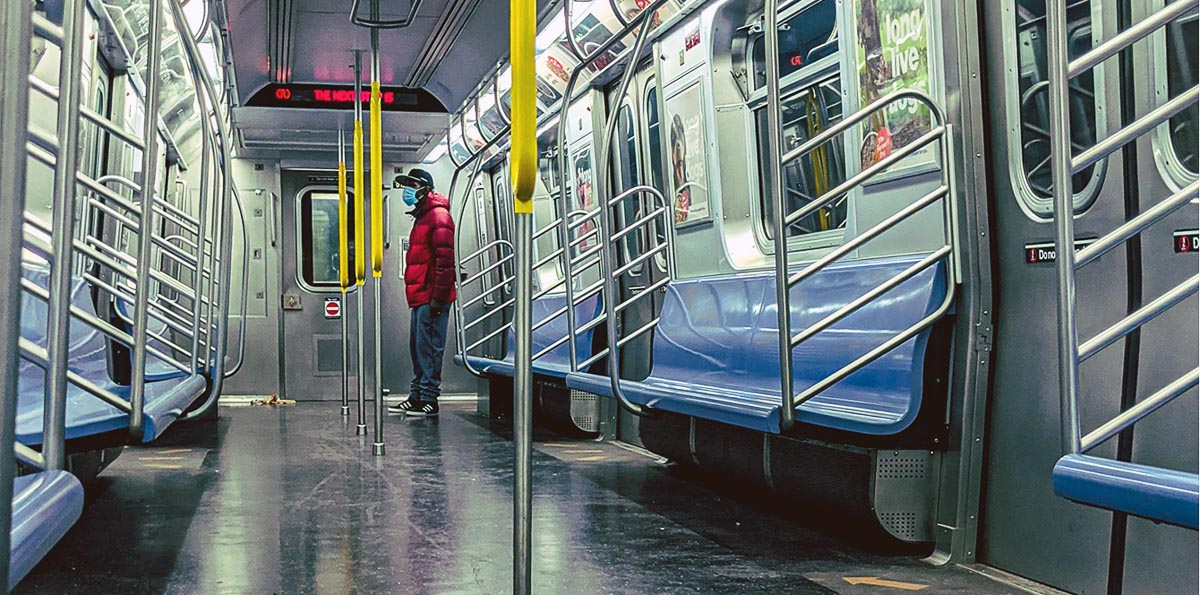At the start of the COVID-19 outbreak, transit agencies ordered blunt service cuts across their system, ignoring that riders’ travel needs varied. These decisions resulted in mostly BIPOC (Black, Indigenous and people of color) essential workers riding, sometimes in cramped conditions, while routes catering to mostly white-collar, white workers emptied. Riders did not “receive resources based on their needs and their potential to benefit,” as Chicagoland Equity Delegation defines equitable distribution of resources.
Higher victim rates from COVID-19 among BIPOC as well as civil unrest about racism and violence against Black people have underscored the imperative of an equitable society — and the failures to realize one, to date.
In transit, equity goes far beyond quantitatively assessing how service is distributed, yet that is the extent of most transit agencies’ equity work. This one-dimensional understanding has hampered the transit field from achieving equity — long before the tumult of 2020.
Read our series examining the intersection of race, equity and public transit in America, featuring insights from transit advocates and experts.
Part 1: “Racism has shaped public transit, and it’s riddled with inequities”
Part 2: “What transit agencies get wrong about equity, and how to get it right”
Part 3: “What transit equity means to a transit-dependent rider in a car-centric city”
Part 4: “To tackle pandemic racism, we need to take action, not just take to social media”
Equity acknowledges that racism, classism and other injustices have created barriers that make it hard for some people to access a system, and it corrects by committing extra resources to marginalized groups so they can fully participate. The Urban Sustainability Directors Network identities four forms of equity, which we apply to transit:
► Distributional equity asks if effective and safe transit is available to all, and if its burdens — like air pollution — are equally shared. Extensive analysis on how transit serves people measures distributional equity.
► Procedural equity ensures that everyone who would ride transit can contribute opinions, ideas and information that affect decisions about how transit operates. Robust public engagement creates space for procedural equity.
► Structural equity relates to who holds decision-making power over operations. Transit workforces and governing bodies must reflect the diversity of the communities they serve, empower all workers to decision-making and legitimize their contributions.
► Restorative equity can be understood as justice. It acknowledges systemic harms — past and ongoing — against certain people and ensures commensurate investments to repair those harms. The push to fund public transit, equal to its worth to communities, combats policies that chronically devalue transit because policymakers disregard it as a core service for low-income people of color.
Restorative equity should be the ultimate goal of equitable planning and investment, but partially addressing just one facet of equity is tantamount to failure. Transit agencies must begin with a multidimensional approach to equity.
The problem with Title VI
Title VI of the 1964 Civil Rights Act legally requires that transit providers meet a standard for distributional equity. Title VI, however, is rife with flaws — including a weak mandate that limits inequitable outcomes but is not meant to advance equity, and autonomy for agencies to decide when the check is needed and how to interpret the results.
For an industry in which numbers drive most decisions, Title VI provides a comfortable, rubber-stamp method to meet the federal equity mandate with handy population data. But it creates the opportunity for transit agencies to too easily conduct an un-nuanced analysis and feel absolved from doing additional work that’s necessary to achieve actual equity in their system — at the expense of their riders.

Photo by Mike Von / Unsplash
What else are agencies missing about equity?
The data treatment
Transit analysts should use more types of data to validate their conclusions about distributional equity. Quantitative metrics like access to opportunity and travel time comparisons show how well transit gets people to and from destinations. Disaggregated by demographics, these metrics evaluate how effectively transit serves different types of people.
However, agencies overlook qualitative data, though it is as powerful as quantitative data. Narratives from riders reveal rich information, such as people’s real-life experiences on transit or their reactions to future projects. Qualitative data is truthful, nuanced and understandable, and it persuasively conveys the heart of an issue.
Contradictions in data shouldn’t be a concern — instead, they should be seen as a valuable opportunity. Figuring out why results diverge leads to a better understanding of equity. And if several independent metrics predict an equitable outcome, one can reasonably expect an equitable outcome.
Reaching out
Public engagement generates qualitative data and builds procedural equity. But, traditionally, lengthy public comment follows jargon-filled presentations on weeknights in government buildings. Attendees skew old and white. This format signals to many — those who are working, who have higher-priority family duties, who don’t trust the government to act in their best interests or who feel alone in the room — that they are not welcome and their input is not important.
Where, when, and by whom engagements are hosted determine who participates. Therefore, organizers must provide diverse options to include everyone. The exchange of information from community members to agency officials has to be the priority, not the other way around. Outreach organizers should share vital information in plain language (including non-English), then engage participants in meaningful discussions. Transit agencies should recognize the value of participants’ time and information by compensating them.
Finally, transit officials need to report on what they heard from community members, instead of just what they decided to do. This demonstrates to the public that their contributions are useful, and it forces agencies to be accountable and transparent to them. (If the decision doesn’t reflect the public’s stated desires, why not?).
Using a tenth of their Better Bus Stop budget, Minnesota’s Metro Transit paid community groups to do outreach in low-income neighborhoods of color. Neighbors were approached on buses, at farmers’ markets, and during other events and asked to take part in quick surveys and focus groups, through which their input was gathered on placing bus shelters and other amenities equitably throughout the system. Metro Transit used this qualitative data to rewrite how they prioritize bus stop improvements, publishing what they learned from the process and how that affected their final decisions.
Pivoting to procedural equity won’t require a moonshot from transit agencies, just a new mindset for what it looks like. There isn’t a formula solving “enough” engagement — it isn’t reached by x-number of public meetings or y-number of participants. It’s reached when quality and representative data has been collected. When it comes to a transit project that costs millions of dollars or more, it is worth spending a small fraction of that to collect authentic input from the people the project is intended to serve.
Organizational structure
Inequities exist within the organizational structure of transit agencies themselves — where decision-making power lies and how agency resources are distributed.
Overwhelmingly, the executive and board leadership of transit agencies are white men, and, primarily, it’s white professionals who make the everyday policy, planning and budgetary decisions about transit. Often, those most affected by these decisions have no part in making them — including BIPOC riders and frontline transit workers.
Some transit agencies are diversifying their workforces to combat the under-representation of women and people of color in the field. But emphasizing representation and diversity alone leads to tokenism, not equity.
Structural equity requires weaving accountability, empowerment and dignity for all workers into the fabric of the agency — it requires resource reallocation, organizational support and commitment from leadership. Practically, revising payment structures, communication channels, hiring and advancement practices, funding for race and equity offices, and plans with time-bound performance goals help to tilt an agency toward structural equity.
The Maryland Transit Authority’s InReach program recognizes the expertise of its frontline workers by seeking their feedback for service planning decisions and by engaging them in ongoing conversations with leadership. The InReach coordinator, the chief of engagement and other agency divisions fold internal workforce contributions and external public perspectives into agency decisions on operations and management. So far, these efforts to integrate the knowledge of both the riding public and frontline workforce into agency practice have paid off. Thirty percent of schedule and bus stop changes in February 2020 came directly from operator feedback, customer complaints are down by 15%, bus service compliments are up 59% and on-time performance has drastically improved.
Justice and restorative equity
Restorative equity ties distributional, procedural and structural equity together by requiring a full accounting of the history of discrimination and its impacts. In transportation, agencies are discretely responsible for under-resourced, unaccountable public engagement practices and unrepresentative agency workforces. They are also privy to policies that have led to the broader oppression of BIPOC people — such as funneling resources away from urban transit systems, which many low-income people of color use, while major public investments in highways and railroads have helped to racially segregate suburbs. Restorative equity allows transit agencies to acknowledge — then redress — how discrimination and exclusion pervade practices.
As transit agencies fight for emergency federal financial assistance to maintain operations and service amid the COVID-19 crisis, the threat of severe financial shortfalls looms even greater.
Simultaneously, widespread protests calling for racial justice have spurred a reckoning of systemic racism in America. Acknowledging how disinvestment in public transit parallels the disinvestment BIPOC communities have long faced is key to rectifying an inequitable public transit system. Restorative equity must drive transit agencies’ COVID-19 self-advocacy; the chronic underfunding of transit agencies as a result of racist and classist public policy is not acceptable and agencies must advocate for appropriate levels of financial support.
All transit agencies must grapple with committing the resources necessary to effectively identify inequity and remedy it. But in 2020, the mandate to ensure an equitable transportation system is more urgent than ever. Centering equity cannot be optional for transportation planning and investment to appropriately serve the riding public and improve the mobility outcomes of local riders, workers and communities.
Mary Buchanan a senior research associate at TransitCenter, a public transit think tank and advocacy group in New York.
Natalee Rivera is a TransitCenter graduate program fellow.

